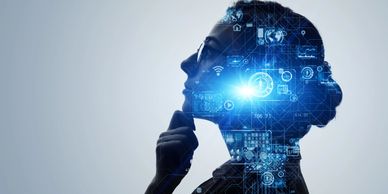OralFacial Myofunctional Therapy
What is it?
Airway Specialist
Airway Specialist

Myo means muscle. So Myofunctional means "Muscle Function". Myofunctional Therapy can be anywhere in the body. Here at Airway Envy, we focus on just the muscles of the oral cavity and surrounding facial muscles. Myo is physical therapy for your lips, tongue, cheeks and surrounding facial muscles.
Airway Specialist
Airway Specialist
Airway Specialist

-Your breathing and airway is the FOCUS of therapy.
-Your tongue, nose and lips are PART of your airway.
-Tongue and nose dysfunction AFFECT the airway.
2015 Myofunctional Meta-Analysis:
-Myo decreases AHI decreases by 62% in children and 50% in adults.
Why do it?
Airway Specialist
Why do it?

We can develop habits of using muscles improperly. For instance, some people develop a dysfunctional swallow, called a tongue thrust. With a tongue thrust, we compensate with muscles that aren't designed to be used together. We swallow 2,000 times a day. Symptoms such as ortho relapse, TMD pain, headaches, sleep apnea, snoring and digestive problems can show up eventually just from swallowing improperly.
Is it new?
How long does therapy take?
Why do it?

-From 1830’s to 1860’s George Catlin visited more than 150 native tribes from North, Central and South America.
-He noted straight teeth, symmetrical faces, low infant mortality, low death rates and disease. ALL of them were nasal breathers.
-1940 Myofunctional societies started to form.
-70-90’s were the dark ages in Myo.
-2000’s was a re-recognition of Myo.
-2010 significant movement forward due to research.
How does it work?
How long does therapy take?
How long does therapy take?

Similar to speech therapy. We teach people exercises for the face, lips and tongue.
-We restore normal function with 4 goals
Nasal breathing all day and night
Lips sealed all day and night
High tongue posture all day and night
Correct swallowing all day and night
How long does therapy take?
How long does therapy take?
How long does therapy take?

MyoFunctional Therapy sessions are every 2 weeks. Most clients finish up therapy in 10 -12 sessions. Initial Comprehensive exam is in person and therapy sessions are typically teletherapy. I may refer you to certain specialist like an ENT, Orthodontist, Oral Surgeon, Maxillofacial Surgeon, Sleep Medicine Doctor or Dentist to help with your journey.
Lets talk about tongue posture!

Get that tongue up!
-Ideal placement is tip of tongue behind front teeth and rest of tongue suctioned up in the back.
-Tongue up: stimulates nerves.
-Sends message to the parasympathetic nervous system.
You’re safe. You’re fine
-Tongue down: No stimulation of nerves.

Our tongue is a scaffold for our teeth
When our tongue is low, the pressure from our lips and checks will move our teeth. Just like with pressure from orthodontics with straighten our teeth, low tongue posture will cave our teeth in.

Tongue position affects growth
-Tongue position affects the growth of the Maxilla. The Maxilla is your upper jaw and includes the midface, floor of eyes, sinuses, nasal passage and cheekbones. Growth of the Maxilla affects your bite and TMJ. Proper growth also creates room for master glands, skeletal development, eyesight, hearing and function of organs and can also affect pelvic opening.
-Underdeveloped Maxilla can create head and neck pain, headaches, TMJ disorder, sleep apnea, deviated septum and Sleep Disordered Breathing (SDB).
Sleep Disordered Breathing
Mouth Breathing
Mouth Breathing
Mouth Breathing
When your mouth is open, you loose ability to keep your tongue out of your throat, disrupting your sleep
Children who chronically mouth breath, become adults with obstructive sleep apnea.
Mouth breathing increases breathing by about 50%. This results in 10-20% LESS oxygen. Fast breathing increases stress.
Mouth breathing can, and often leads to snoring.
Snoring
Mouth Breathing
Mouth Breathing
Vibrations caused by chronic snoring damages nerve endings in soft palate. Like your hands going numb after using a chainsaw. This weakens muscles further aggravating snoring.
Chronic snoring can, and often leads to Upper Airway Resistance Syndrome (UARS).
Upper Airway Resistance Syndrome
Upper Airway Resistance Syndrome
Upper Airway Resistance Syndrome
Upper Airway Resistance Syndrome (UARS) occurs when your body senses the airway may obstruct. It puts your body on high alert and can significantly disrupt your sleep.
Often seen in thin body types with small jaws and a history of orthodontics.
Frequently missed on sleep studies and mistaken as Chronic Fatigue Syndrome
UARS can lead to Obstructive Sleep Apnea.
Obstructive Sleep Apnea
Upper Airway Resistance Syndrome
Upper Airway Resistance Syndrome
Obstructive Sleep Apnea occurs when you stop breathing for 10 seconds or more.
Contact Karie to schedule or with questions
airwayenvy.com
This website uses cookies.
We use cookies to analyze website traffic and optimize your website experience. By accepting our use of cookies, your data will be aggregated with all other user data.